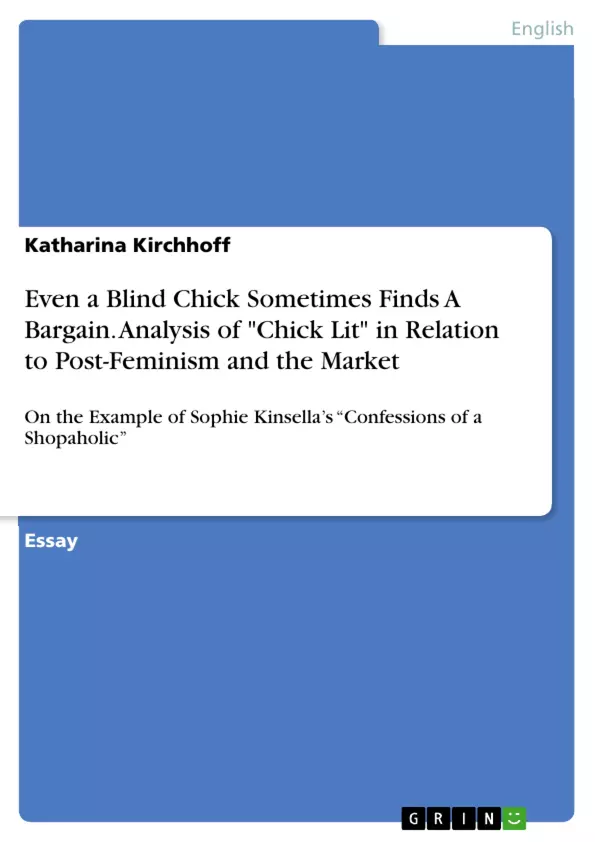The twenty-first century heroine fights in a Prada dress, in the jungle of big cities, not for world peace but for bargain buys.
Today’s heroines also have to be versatile to meet the requirements of post-feminism, popular culture and neo-liberalism: they work, they care for friends, they have to fight for Mr.Right (so they don’t end up as a spinster eaten by cats), they do Brazilian Waxing and most importantly, they shop. When Helen Fielding’s Bridget Jones stated that she had decided to “go shopping and stop obsessing” (Fielding 80) it seemed as if a wall was pulled down and women in "Chick Lit" went shopping as if there was no tomorrow. Thanks to credit cards, there is indeed no limit. On the one hand, those women are mostly educated and independent with a solid income, but on the other hand they get into debt for the newest Hermes scarf to achieve an ideal which is propagated in popular culture.
Here the question emerges: What significance does the fashion and beauty industry have for women in the 21st century? This essay will answer that question, proving that while the fashion and beauty industry as well as post-feminism propagates the economic independence of women and, in connection, massive consumerism as a symbol for the liberation of women, shopping instead reflects the subliminal oppression of women by the market. The background and theoretical framework for this thesis is provided by Angela McRobbie, one of the leading feminist theorists of the 21st century, who states that the fashion and beauty industry “appears to displace traditional modes of patriarchal authority” (McRobbie 61). My object of analysis is Sophie Kinsella’s "Chick Lit" novel "Confessions of a Shopaholic", as to the heroines in "Chick Lit" shopping is a central and essential part of their lives and is presented as a way to create one’s identity, according to the ideals of popular culture under the guidance of the fashion and beauty industry.
"Chick Lit" heroines are often presented as fashionistas who define themselves by the clothes and brands they wear always desperately trying to prove their individuality and to confirm their identity. Free and excessive shopping is put on a level with liberation and emancipation, as "Chick Lit" fashionistas are economically independent working women. This is where the aspect of post-feminism comes into account, as it goes hand in hand with neo-liberal ideas like freedom through economic independence, individuality and competition.
Table of Contents
- INTRODUCTION
- IDENTITY, CONSUMPTION AND INDIVIDUALITY- THE VICIOUS CIRCLE OF THE MARKET
- FEMINISM, POST-FEMINISM AND WOMEN AS THE NEW TARGETS OF THE MARKET
- PATRIARCHY WEARS PRADA- THE FASHION AND BEAUTY INDUSTRY AS THE NEW PATRIARCHY IN ANGELA MCROBBIE'S THE AFTERMATH OF FEMINISM AND SOPHIE KINSELLA'S SHOPAHOLIC
- CONCLUSION
Objectives and Key Themes
This essay explores the connection between the fashion and beauty industry and the identity construction of women in the 21st century. It argues that while the fashion industry promotes the idea of economic independence for women, this is ultimately a means of subliminal oppression through increased consumerism. The essay analyzes Sophie Kinsella's Chick Lit novel "Confessions of a Shopaholic" to demonstrate how shopping is presented as a central aspect of female identity, reflecting the influence of post-feminism and neo-liberal ideals. Key themes include:- The role of consumption in constructing identity
- The influence of post-feminism and neo-liberalism on women's lives
- The fashion and beauty industry as a tool of female oppression
- The representation of shopping and consumerism in Chick Lit
- The concept of "othering" and its application to feminist discourse
Chapter Summaries
Introduction
This chapter introduces the topic of shopping and consumerism as a means of identity construction for women in the 21st century. It critiques the notion that shopping represents liberation and emancipation, suggesting instead that it reflects a subliminal form of oppression through the market. The essay sets out its theoretical framework, drawing on the work of feminist theorists such as Angela McRobbie and using Sophie Kinsella's "Confessions of a Shopaholic" as its primary object of analysis.Identity, Consumption and Individuality- The Vicious Circle of the Market
This section examines the relationship between identity, consumption, and the market. It explores the complex concept of "identity" and how it is influenced by external factors such as gender, class, and culture. The chapter discusses how the 21st century culture of mass production and consumption has led to the commodification of culture, with consumption becoming a defining factor in identity construction. It further examines the role of the market, particularly the fashion and beauty industry, in shaping and influencing female identity.Feminism, Post-feminism and Women as the New Targets of the Market
This chapter explores the relationship between feminism, post-feminism, and the market. It argues that while the feminist movement has seemingly achieved equality for women, the market has adapted by targeting a new group of well-educated, middle-class, working women with its products. It examines how the fashion and beauty industry, in conjunction with post-feminist ideology, has created a "new category of womanhood" that embraces consumerism as a sign of empowerment, while simultaneously promoting "new neurotic dependencies" on the market.Keywords
This essay focuses on the themes of identity, consumption, post-feminism, neo-liberalism, the fashion and beauty industry, Chick Lit, and the role of the market in shaping female identities. Other key concepts include "othering," "commodification of culture," and the "vicious circle of the market."- Quote paper
- Katharina Kirchhoff (Author), 2014, Even a Blind Chick Sometimes Finds A Bargain. Analysis of "Chick Lit" in Relation to Post-Feminism and the Market, Munich, GRIN Verlag, https://www.grin.com/document/289030



